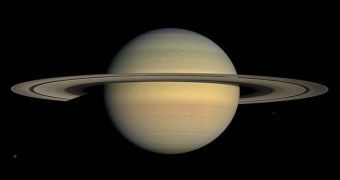Studies conducted using a NASA orbiter are showing that the radio waves emanating from both the north and south pole on Saturn are different in their variations. Researchers say that these variations also change with seasons, and that the wave characteristics were even exchanged between the poles.
At one point in time, the type and frequency of radio waves that are now emitted from the North Pole were released from the South Pole, and vice-versa. Experts hypothesize that a wide variety of phenomena might be at work to underly these variations.
In order to figure them out, researchers are using the NASA Cassini orbiter, which has been surveying the gas giant, its ring system and its moons since achieving orbital insertion on July 1, 2004. Thus far, the data it provided have proven invaluable for astronomers.
According to astrophysicists, the radio wave emissions are produced as a side-effect, by the same processes that leads to the formation of tremendously bright auroras. The atmospheric lights can be seen on Earth as well, but to a lower extent.
“The rain of electrons into the atmosphere that produces the auroras also produces the radio emissions and affects the magnetic field, so scientists think that all these variations we see are related to the Sun's changing influence on the planet,” explains scientist Stanley Cowley.
Using Saturn as a proxy for solar studies is an interesting, albeit unexpected prospect, adds the expert. He is a co-investigator on the Cassini magnetometer instrument science team, Daily Galaxy reports.
“These data just go to show how weird Saturn is,” adds the leader of the Cassini radio and plasma wave science instrument team, Don Gurnett. He is also a professor of physics at the University of Iowa in Iowa City.
“We thought we understood these radio wave patterns at gas giants, since Jupiter was so straightforward. Without Cassini's long stay, scientists wouldn't have understood that the radio emissions from Saturn are so different,” he goes on to say.
Interactions between solar winds and the massive magnetic bubble protecting Saturn will most likely be studied for years to come. Experts still have a long way to go before they understand these intricate dances, as well as how the numerous Saturnine moons fit into this picture.

 14 DAY TRIAL //
14 DAY TRIAL //